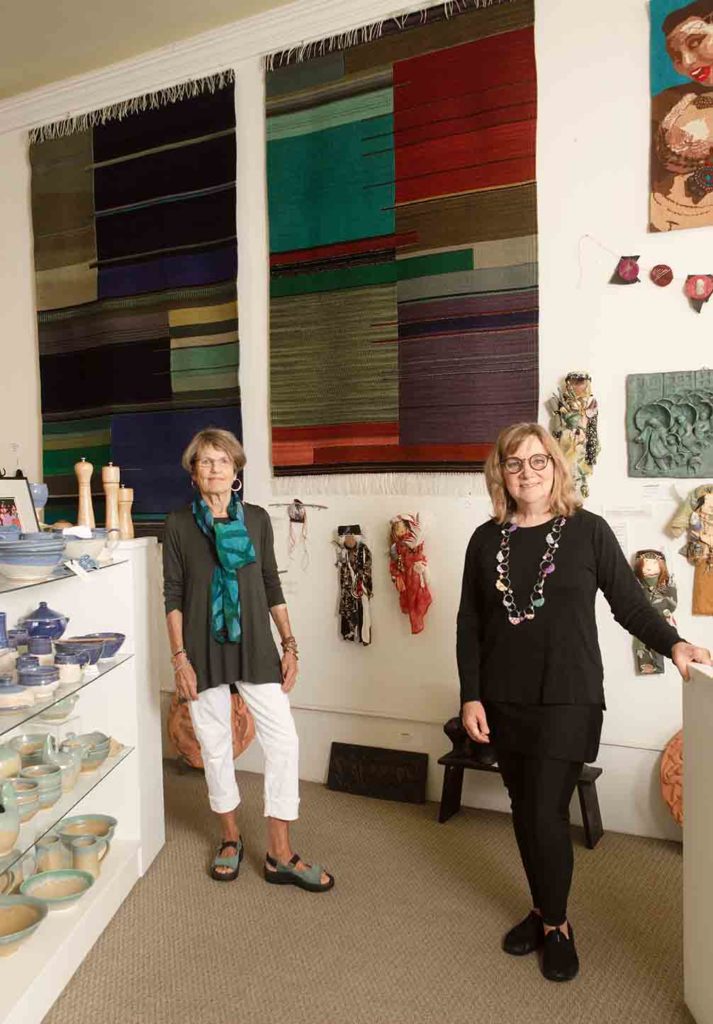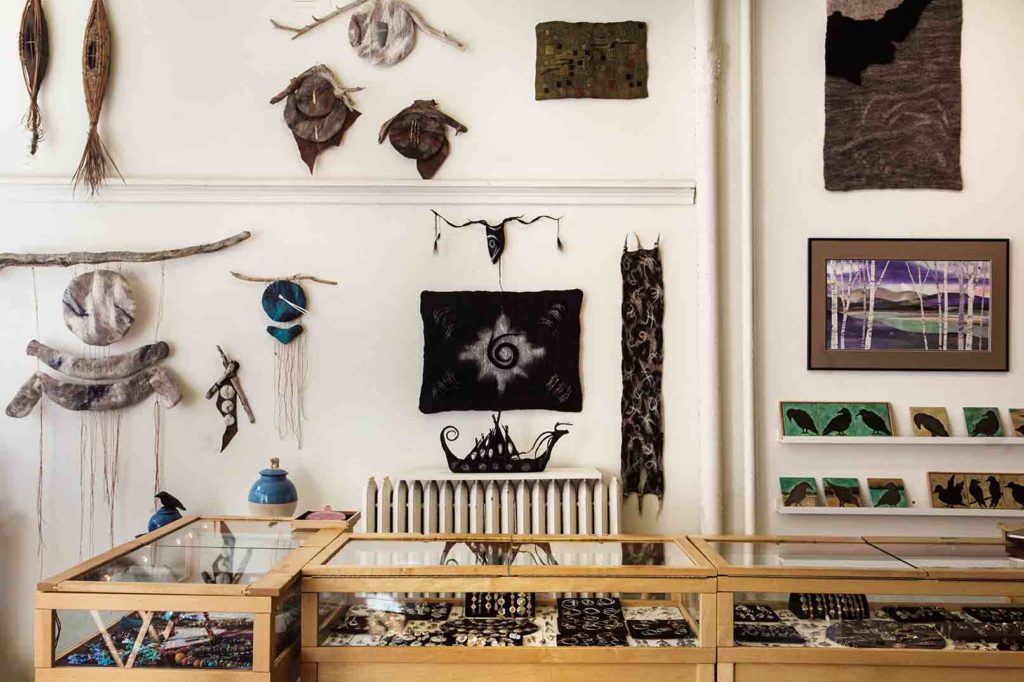Art for the Soul

Art for the Soul
When the pandemic struck, supporters of Markings in Bath rallied behind the cooperative art gallery
by Jason Palumbo
Photography by Heidi Kirn
Issue: October 2020
A moment of awe, a sense of wonder, an intimate feeling of connection—these are the sensations I felt on first finding myself in Markings Gallery after moving with my wife from New York City to a small community in midcoast Maine. Markings, an artists’ cooperative with three large display rooms nestled on a lively little street in the shipbuilding town of Bath, is the shop that you bring all your out-of-town friends and relatives to see. There’s a magic to Markings that needs to be shared.
This year Markings Gallery is celebrating its ten-year anniversary. Normally Markings, known in the community for its gallery shows and artists talks, would throw a big bash to mark this historic accomplishment. Yet even in these strange times, a local treasure like Markings has earned a moment of recognition and celebration.
It is a big accomplishment for a gallery that is run by and for artists to reach ten years in such an expansive storefront. It’s rare for a gallery of this kind to thrive for so long. Unlike most galleries, Markings does not buy art to resell, or sell pieces on commission. Nor does it feature any works by artists who are not Maine residents. Markings is an artists’ cooperative featuring 60 artists and craftspeople, including my wife, Sara Palumbo, a felt artist. The gallery prides itself on being a place for artists to sell art the way that they want to, a platform for its members to reach enthusiasts, fans, and collectors.

When the pandemic threatened the survival of Markings Gallery, the members of the cooperative organized a fundraiser that raised $20,000.
“Fans” and “enthusiasts” might sound like hyperbolic words for a craft store, but the patrons proved themselves to be very much that when they voted with their dollars this spring. When the pandemic struck, and all the retail shops in Maine went into lockdown, many galleries had to fold. Other shops near Markings along Front Street in Bath boarded up for good. Nan Kilbourn-Tara, the founder and acting manager of Markings, would not go down without a fight. She gathered the members of the cooperative and planned an online fundraiser to carry the gallery through lean times. It turned out that Markings had more than fans; it had committed supporters. The gallery met its fundraising goal within three weeks, raising $20,000.
Kilbourn-Tara is an experienced businesswoman and talented tile artist who exudes confidence and genuineness. When speaking with her, you get a sense of what makes Markings such a special place in the community. “I’ve heard more than once that we stack up with the best craft shops in America, from people coming from New York, Boston, Philadelphia,” she says. “The diversity and excellence of our artists’ work is our strength. Keeping both the mix and the balance exciting is our challenge, and that recipe is always changing. We work hard to find the best of the best.”
While Markings has no owner or executives, it does have strong leadership. The other chief leader of Markings is Susan Mills, the gallery’s manager and a skilled textile artist. (Mills’s work is what most captivated me and kept me coming back every time I found myself in Bath.) Mills credits Kilbourn-Tara with the store’s success in finding the right balance of ever-changing talent across a broad range of media. She also points to Kilbourn-Tara’s artistic eye in the staging of the new art in concert with the hugely diverse array of pieces to be found in the gallery. “Nan does the curating and brings her own keen vision to every piece that comes in the gallery,” Mills says. “Consideration is always given to see how pieces work together with colors, textures, and symbolism. Whenever Markings has taken on a new artist there are lots of conversations that precede this. The art is highly juried. We make sure that we all appreciate the new work and have confidence that we can represent the artist and connect their work to the visitors that will resonate with it.”
The gallery is populated by an enormously diverse range of media. The fiber section’s range of colors, designs, and textures is extraordinary. Felt and mixed media garments hang juxtaposed with a creatively unbound world of wall-hanging and sculptural pieces, including fine hand-woven rugs and tapestries, appliquéd fiber paintings, constructions, and fiber vessels. Clay pieces including tiles and pottery, with designs ranging from highly realistic to abstract, catch the light and the eye at every turn. Porcelain, earthenware, stoneware, saltware, and raku clay work are all represented.

A wool vest by Marianne Senechal. 
A wooden vase by Jack Lilley.

Markings’s jewelry is equally diverse, including distinctive styles and techniques worked in gold and silver, and naturalistic pieces bearing stones and pearls. Vintage elements combine with newly fabricated work to produce one-of-a-kind results. Hammered, repoussé, and organic cast silverwork lie side by side with innovative, wildly colorful pieces made from polymer resins—pieces that push the envelope with innovative techniques. Evocative wood carvings of all the birds and sea creatures of the region in a wide variety of woods are provided by Wayne Robbins, a biologist-turned-artist gallery member. Finely turned wooden bowls and other functional pieces pepper the gallery, as well as decorative and sculptural works. There are two artists with stained glass work in the gallery. Another artist makes small glass objects and ornaments. One of Maine’s most dazzling glass artists, Stephanie Sersich, provides highly unusual jewelry that is richly decorative, colorful, and collectible.
The eclectic mix of art in the gallery is unique and powerful. Maybe this is what happens when a gallery is run entirely by the artists. The spirit of the place is focused on the pieces, rather than the profits. It is a place to luxuriate in art for the sake of art, craft for the celebration of skillful eyes and hands. It is a place that makes you feel. A visitor has described it as like being in a museum, only more accessible, attainable. Each piece has meaning, authenticity, and is entirely one-of-a-kind.
Kilbourn-Tara and Mills hope, even though they can’t throw a ten-year anniversary party, that people will still be able to come and celebrate in their own way, in smaller, more intimate celebrations of what the gallery means to each individual. Reflecting on the success of the store and the fundraising drive that carried it through the statewide shutdown, Mills says, “I think it shows what people truly value. Art feeds the soul.”

The downtown Bath gallery has work by artists and craftspeople from a diverse range of mediums.

